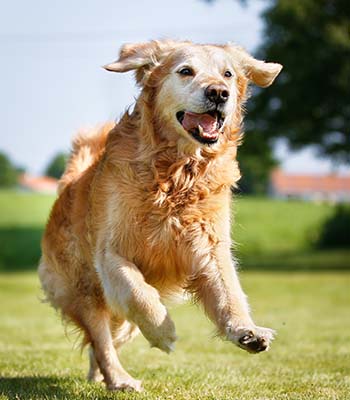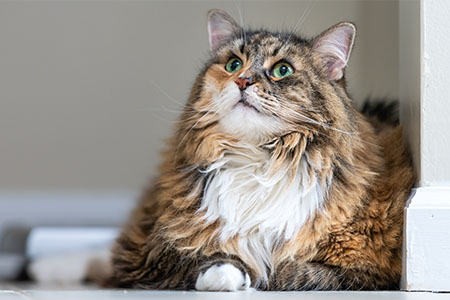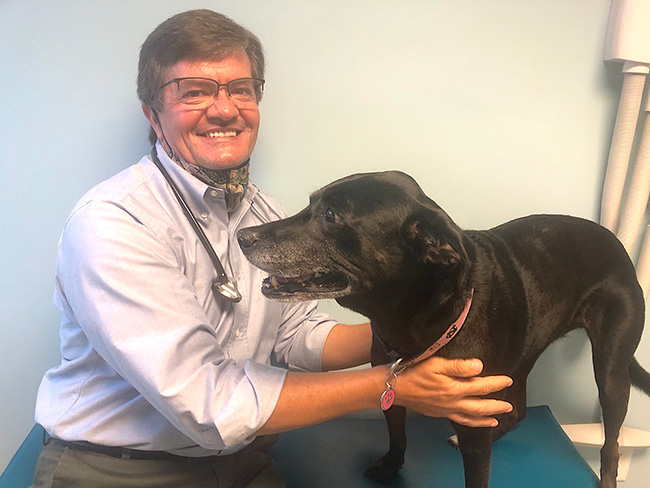How to Help Pets Stay Happy & Healthy as They Age
Pets are living longer now than they ever have before due to advanced veterinary care. But just like people, they slow down and are more likely to have health issues as they grow old. Older pets’ immune systems are not as healthy as those of younger animals; as a result, they can’t fight off diseases or heal as fast as younger pets. Geriatric pets can develop many of the same problems seen in older people, including common ones such as joint issues, kidney and heart disease. They are also prone to hearing and vision loss as they age.
“Dogs and cats will start to show age-related issues similar to a senior human’s experience,” said Dr. Charles Livaudais. “As our pets age faster than people, they need to come in twice a year once they turn seven to head off any problems. If they only come in once a year, it’s like a human only seeing their doctor every 2-4 years.”
Read on for ways you can help your pet age gracefully if you are caring for a senior dog or cat
When is a Cat or Dog Considered to Be a Senior?
 According to the American Veterinary Medical Association (AVMA), cats and small dogs are generally considered geriatric at the age of 7. Larger breed dogs tend to have shorter life spans and are considered geriatric when they are approximately 6 years of age.
According to the American Veterinary Medical Association (AVMA), cats and small dogs are generally considered geriatric at the age of 7. Larger breed dogs tend to have shorter life spans and are considered geriatric when they are approximately 6 years of age.
It is widely thought that one human year equals seven in dog years, which is partially accurate, but the size of the dog can alter that equation by a few years either way. Seven in dog years equals around 45 in human years for a small to medium dog, while a larger dog would compare more to a 54-year old. Ten in dog years could be anywhere from 56-78 in human years, depending again on the size of the dog.
Scheduling exams every six months increases the chances of detecting and successfully treating age-related conditions. According to Dr. Charles, in addition to getting checkups twice a year, some of the most important ways you can help make aging easier for your pet include:
- Keep plenty of water available. Consider elevating the bowl on a stand made for pets to make drinking and eating easier.
- Don’t overfeed your pet. Weight gain can lead to more problems as well as exacerbate issues like arthritis. Keeping your dog on the thinner side is the most important thing you can do to minimize the effects of arthritis.
- Check their food to make sure it’s researched and quality tested by veterinarians and created for seniors. Geriatric pets often need foods that are more readily digested, and have different calorie levels and ingredients, and anti-aging nutrients
- Move it or lose it. As with older people, keeping older pets moving through appropriate exercise helps keep them healthier and more mobile. Keeping your senior dog active will also help prevent weight gain. Make sure they continue to get plenty of regular exercise, unless their joints are hurting, then modify the exercises to accommodate that.
- Get their blood work checked at least annually, or more frequently if your veterinarian recommends in order to monitor certain illnesses or assess the performance of certain medications. This is also a good way to detect any kind of disease and make sure their kidney and liver function is normal.
- Watch for weight fluctuations. Weight gain in geriatric dogs increases the risk of health problems, whereas weight loss is a bigger concern for geriatric cats. Weight loss and increased appetite are hallmarks of hyperthyroidism in cats.
- Keep up with their medications and supplements. Remember to refill prescriptions as needed and try not to skip any doses. Flea prevention is also important. Supplements containing either glucosamine and chondroitin sulfate or fish oil/omega fatty acids may help relieve the symptoms of arthritis.
- Keep your pet mentally active. Alternate their toys on a regular basis. Get a new cat toy ever so often and keep your dog engaged with new treat balls or interactive toys containing treats or parts that they can pull out.
- Make alterations to their home environment as needed. You may need to put down more carpeting around your home so your senior dog will have an easier time getting up and will be less likely to slip on hardwood or tile floors.
Changes in the home environment may also help an older pet who is experiencing stiffness or pain. Things like orthopedic beds, stair steps to help an animal up to higher places (so they don’t have to jump), raised feeding platforms, and so on, can help make your arthritic pet more comfortable. An orthopedic dog bed or a heated dog bed may help senior dogs that are suffering from arthritis and other joint problems.
Look for Changes in Your Senior Pets’ Behavior
Before any medical signs become apparent, behavioral changes are important indicators that something is changing in an older pet, due to medical or other reasons. You, or the family member who most interacts with your pet, need to take note of any changes in your animal’s behavior and routines. If your pet is showing any change in behavior or other warning signs of disease, contact your veterinarian and provide them with a list of changes you’ve observed.
Changes in the way your older pet lies down, gets up, jumps, climbs stairs, walks or runs may be indicators of arthritis. Arthritis occurs in both cats and dogs, but large-breed dogs are especially susceptible. Animals may experience pain from arthritis that is mild to extremely painful, so it’s important to seek treatment and avoid unnecessary suffering. There are a variety of treatments, similar to those for humans, to ease the symptoms of arthritis, including pain medication and joint-supporting supplements.
 Signs of Arthritis in Pets
Signs of Arthritis in Pets
- Favoring a limb
- Difficulty sitting or standing
- Sleeping more
- Seeming to have stiff or sore joints
- Hesitancy to jump, run or climb stairs
- Weight gain
- Decreased activity or interest in play
- Attitude (more irritable) or behavior changes
- Being less alert
Signs of arthritis often are similar to signs of normal aging, so if your pet seems to have any of these symptoms for multiple weeks, have your veterinarian examine them.
Signs of Senility in Your Pet
Your dog may start barking at some invisible threat or stand in a corner randomly and act confused. This condition is referred to as canine cognitive dysfunction (CCD). Although there’s currently no cure for CCD, regular moderate exercise and some sort of mental stimulation can slow your dog’s cognitive decline.
Increase your pet’s social interaction with both humans and other dogs (only the kind, gentle ones) and provide short outings to places that give new sights and smells to an elderly dog. If arthritis prevents long walks, then try swimming programs for dogs or underwater treadmills.
Feline senile dementia, also known as feline cognitive dysfunction (FCD), may occur as a cat ages and can influence their awareness, learning, memory, and responsiveness. Things to watch for you your senior cat include increased meowing, lack of self-grooming, inappropriate elimination, disorientation and anxiety. According to the ASPCA, FCD affects more than 55% of cats aged 11 to 15 years and more than 80% of cats aged 16 to 20 years.
A cat’s cognitive abilities start to decline at around 11 – 12 years of age. Feline senile dementia typically occurs after a cat reaches 15 years old. While there’s no cure, you can make things easier for your cat by avoiding sudden changes to their daily routine. Don’t make drastic changes to the home environment, including moving the furniture, and always keep your cat’s food bowls and litter tray in the same area. This will make it easier for your cat to navigate around the house and lessens the chances of them becoming lost or confused. There are also some medicines that may help cats with FCD and your veterinarian may also consider an anti-anxiety medication if needed.
Conduct Your Own Eye Exam
It’s a normal effect of aging for pets to develop cloudy eyes, a bluish, transparent haze over their pupils. This is called lenticular sclerosis and does not affect your pet’s vision. However, a cloudy white covering on the eye may be symptomatic of cataracts, which do affect vision and can be removed by your vet.
Keep Track of Bumps and Lumps
Work with your vet to make a body map of your pet. This can be a sketch showing both sides of the dog or cat, marked with the location of any known bumps or lumps. There should also be a description of each giving the size, color, and results of fine-needle aspiration, the baseline assessment for any lump. Again, routine checks will indicate if any of the lumps are changing significantly so that some sort of action can be initiated.
Establish a Baseline in Middle-Aged Pets
If you don’t have a senior dog or cat yet, according to the American Kennel Club (AKC), a good way to catch such problems early is to establish a baseline health profile while the dog is in mid-life and still in good health. This would involve an annual exam including screening lab work. Then results of routine annual health-checks can be compared to the baseline in order to identify any changes that may require treatment or a more detailed assessment.
We are here to help your animal age as gracefully as possible and look forward to seeing our senior pets more often so we can head off issues and keep them healthy and happy during their golden years.


